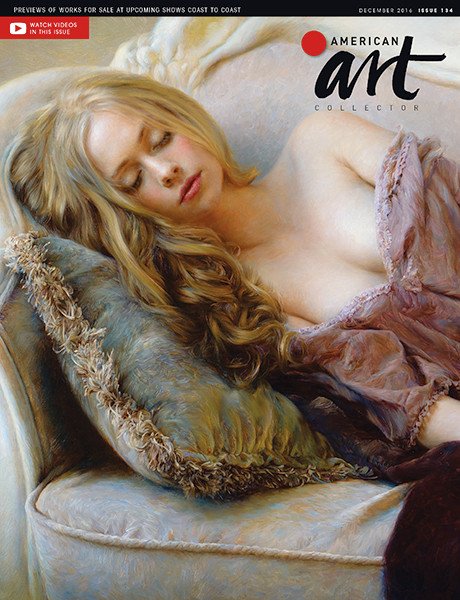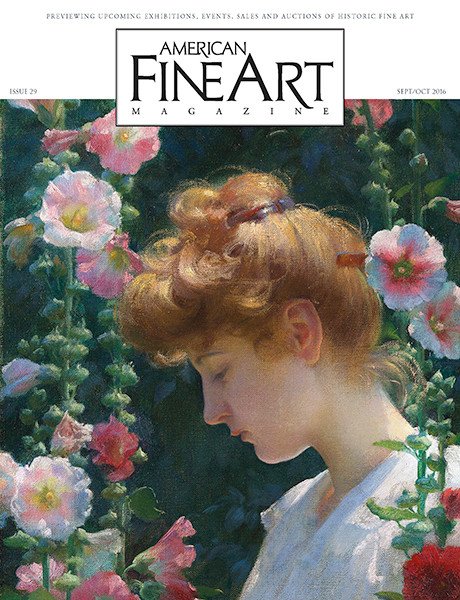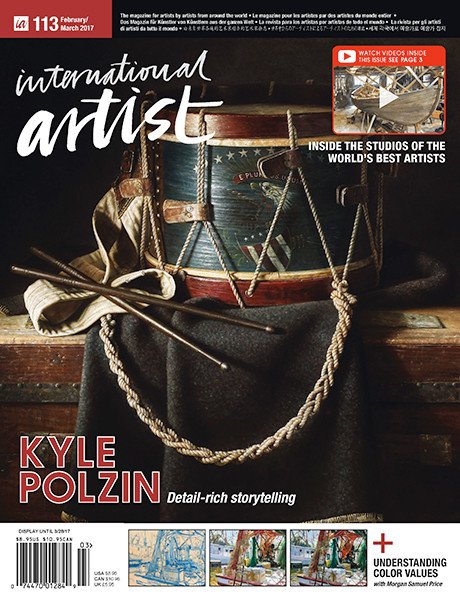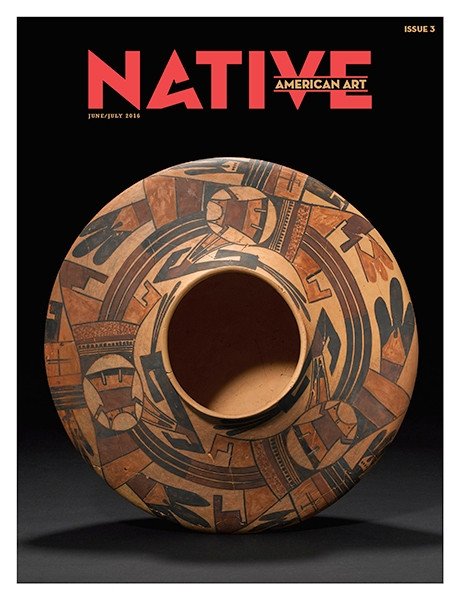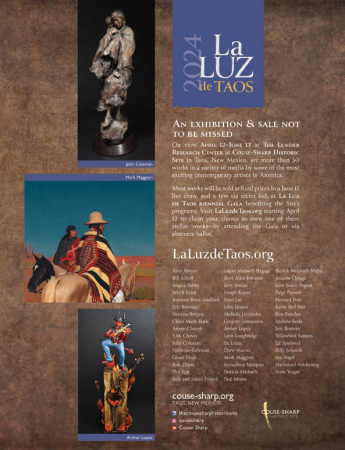The Couse Foundation
The Lunder Research Center, Couse-Sharp Historic Site138 Kit Carson Road
TAOS, NM 87571
5757510369
Email this Gallery
Visit Gallery Website
The Couse Foundation
5/1/2024 - 5/31/2024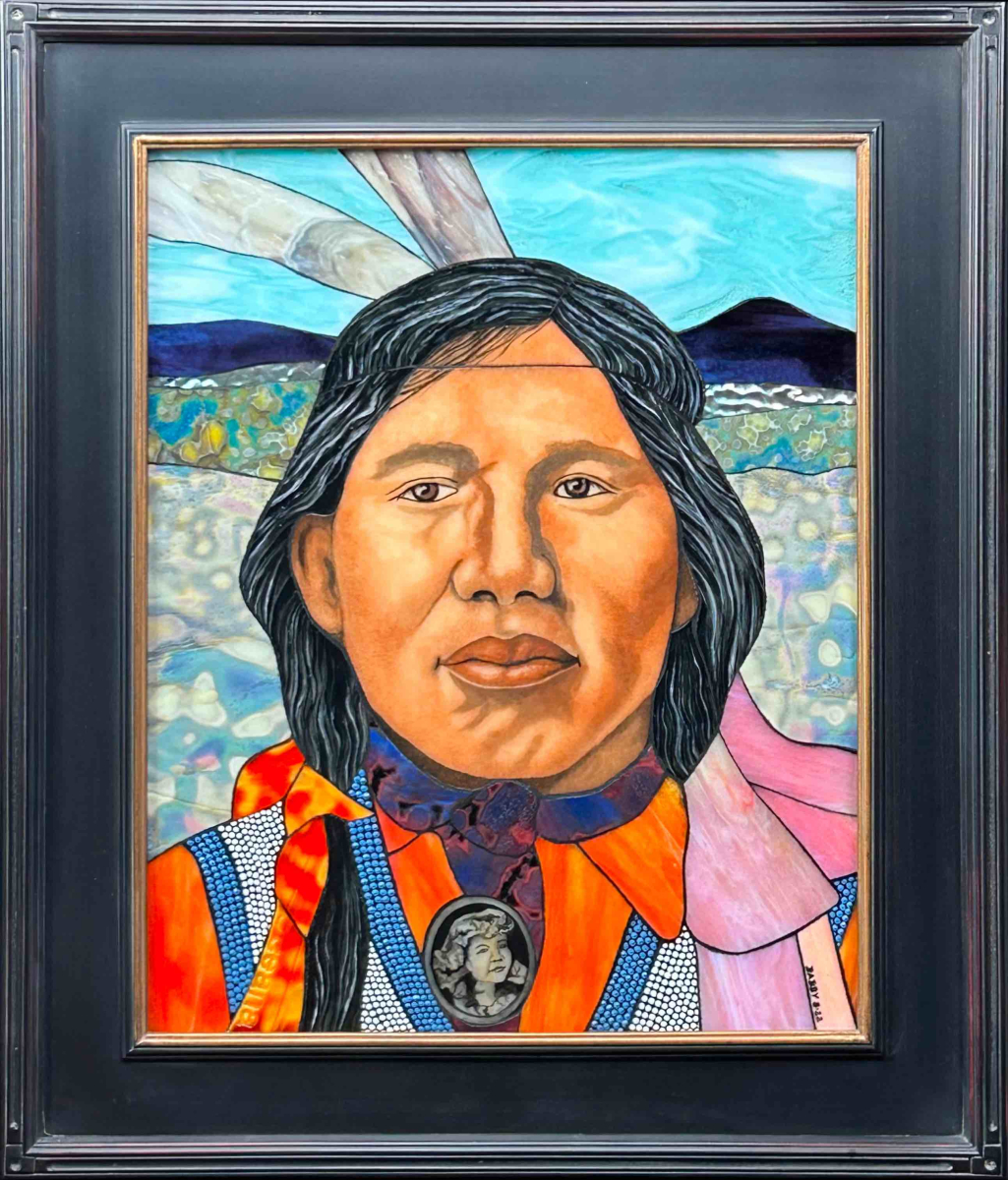
Big Little Bear,
Angela Babby
kiln-fired vitreous enamel on glass mosaic on tile board
20 x 16 inches (L x W)
Angela Babby revives and combines ancient techniques into a unique form of art: enameled glass mosaic. Unlike other glass artists, she expands upon traditional stained glass techniques with kiln-fired enamel details in her mosaic art. Her “glass-on-glass” approach combines her love of painting with the luminosity and saturation of color uniquely expressed in glass. The artist explains, “Glass contains light. When I depict a person from the past in glass, it has a three-dimensional depth that I could never achieve with paint.” A hallmark of her work is how the subject matter strikes the viewer with its emotional content. An enrolled member of the Oglala Lakota Sioux Tribe, Babby’s Lakota ancestry influences her work and the mysterious nature of glass. She received a Bachelor of Fine Arts degree in painting in 1990 from Montana State University in Billings.
angelababby.com
aktalakota.stjo.org
$5,500
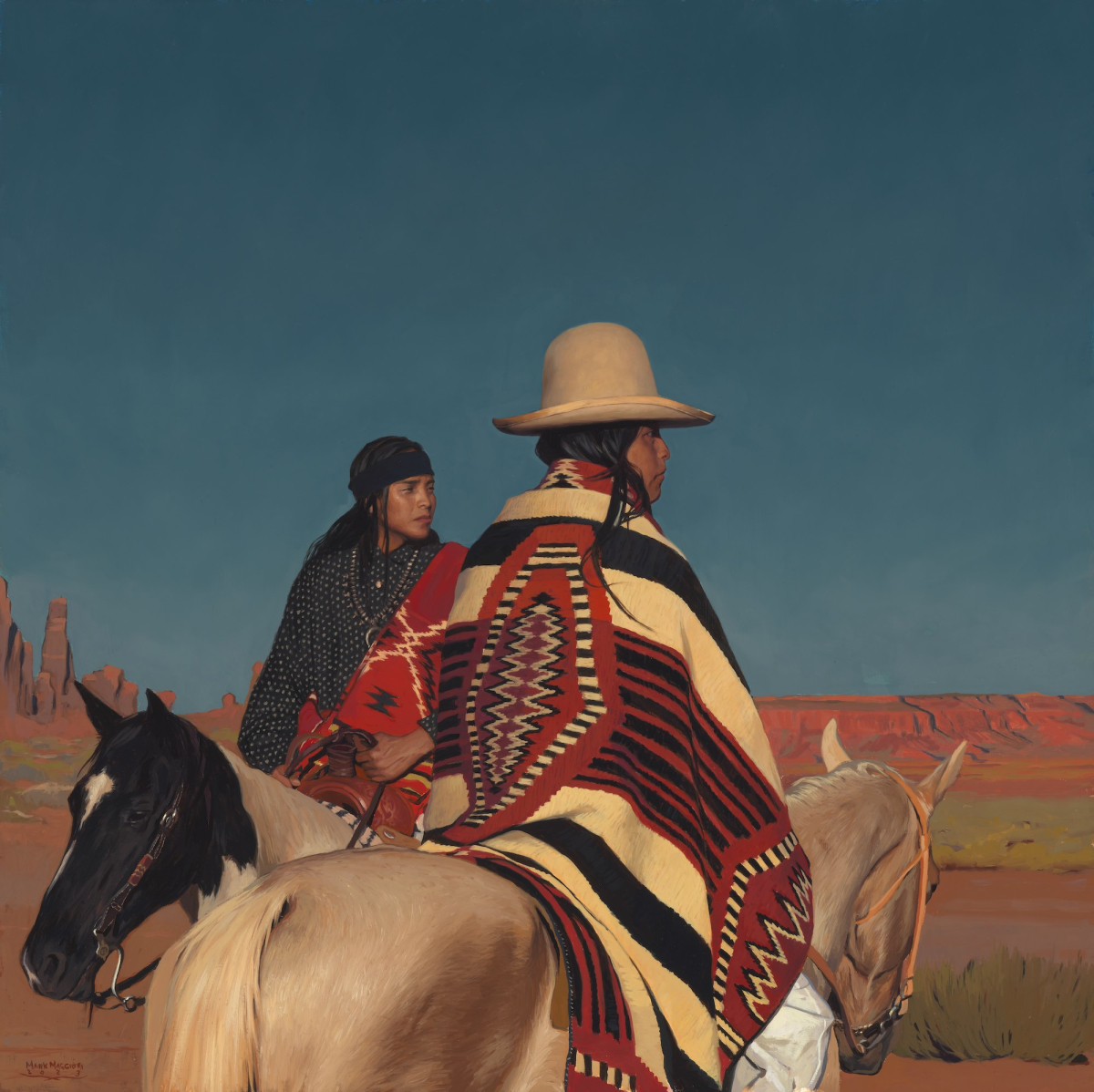
Brother by Blood
Mark Maggiori
oil on panel
26 x 26 inches (L x W)
At the age of 15, Mark Maggiori, who was born in Fontainebleau, France, first glimpsed the American West through the front windshield of a car journeying from New York to San Francisco. Many years later, after an education at the Académie Julian and successful career in the music industry, Maggiori would return to the United States with his wife, artist Petecia Le Fawnhawk. In 2010, following a visit to the National Cowboy and Western Heritage Museum in Oklahoma City, Maggiori was inspired to dedicate his life to documenting the American West. Known for his visions of modern cowboys and the nostalgic West, Maggiori says, “I love to paint and dream about the good old times. Cowboys always represented, for me, a time when America was still a promised land . . . a huge dream for whoever wanted it.” In addition to his scenes of cowboys and open spaces, Maggiori, who bought a home in Taos in 2020, has researched and created work inspired by the people of Taos Pueblo and the photographic archives of E. I. Couse.
markmaggiori.com
The two historic Navajo textiles the models are wearing in this painting are also available for sale as Lots 32 and 33. The winning bidder for the painting will have right of first refusal to purchase the textiles as well. If the winning bidder declines, the normal draw sale for the textiles will be conducted.
Minimum Starting Bid: $45,000*
*This work will be sold by maximum, secret bid.
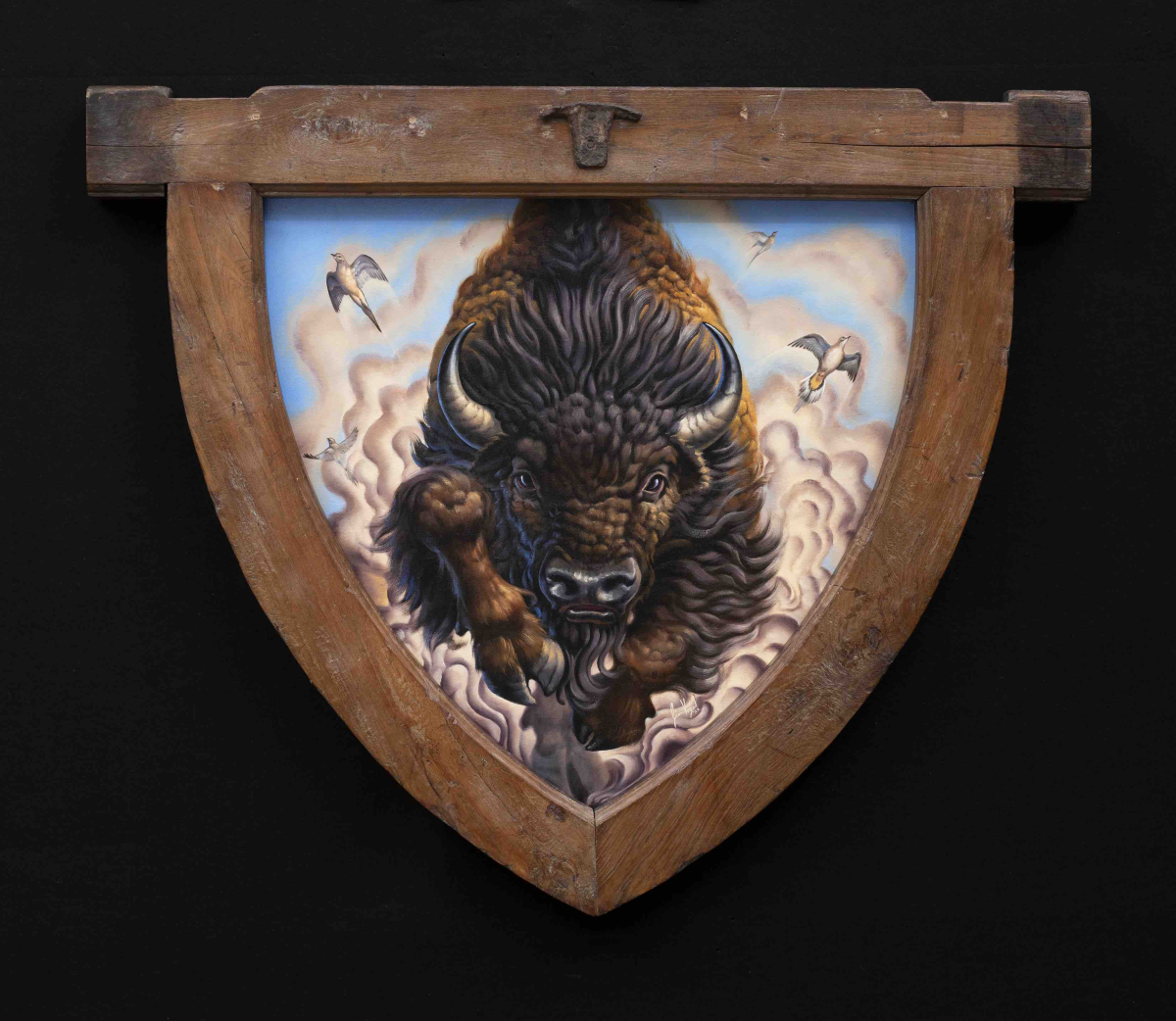
Buffalo Wings
Jim Vogel
oil on canvas panel in antique arched window frame
26.5 x 28 inches (L x W)
Growing up as the self-professed “weird art kid” in Roswell, New Mexico, Jim Vogel comes from a family of storytellers, a background that now pervades his own artwork. At home in the heart of New Mexico, Vogel paints scenes of New Mexican myth and folklore in an attempt to “put images to these stories I’ve heard over and over from my mother and father.” Reminiscent of Thomas Hart Benton’s social realist and regionalist works, Vogel’s narrative paintings feature frequently New Mexico’s working-class and rural poor in an attempt to relate the common man’s struggle. In addition to his paintings, Vogel creates elaborate, handmade frames to enhance his scenes. Based in Dixon, New Mexico, Vogel participated recently in “Taos Six Collection: An Homage to Joseph Henry Sharp” at the Blue Rain Gallery, in which he showed his work Matching the Color of Sangre de Christo, after Joseph Henry Sharp’s The Old Santos Mender.
The frame for Buffalo Wings was made from an old South American door in collaboration with his wife, Christen Vogel.
blueraingallery.com
$15,000

Campfire Stories
Nicholas Coleman
oil on linen
24 x 30 inches (L x W)
Working out of Provo, Utah, Nicholas Coleman was brought up in an artistic home, and by the time he was 21, he knew that he wanted to be an artist like his father, Michael Coleman. Not your “stereotypical” fine artist, Coleman hunts, fishes, and traps in addition to painting naturalistic landscapes. In his compositions, Coleman focuses on the American West and often paints scenes of wildlife, Native American culture, natural history, and exploration. To Coleman, the goal of his work is to “preserve the heritage of the American West,” which, he notes, has “many untold stories to tell!” Coleman hopes that audience members viewing his work are provoked to explore the natural environment, a desire that comes from his belief that individuals who value Western landscapes will be motivated to protect them.
In addition to his father, Coleman has been inspired by the work of artists such as Winslow Homer, John Singer Sargent, and Philip R. Goodwin. Despite these numerous influences, Coleman asserts that, “I’ll paint what I paint. I know who I am. I think that’s a big part of . . . what I’m doing.”
nicholascolemanart.com
$14,000
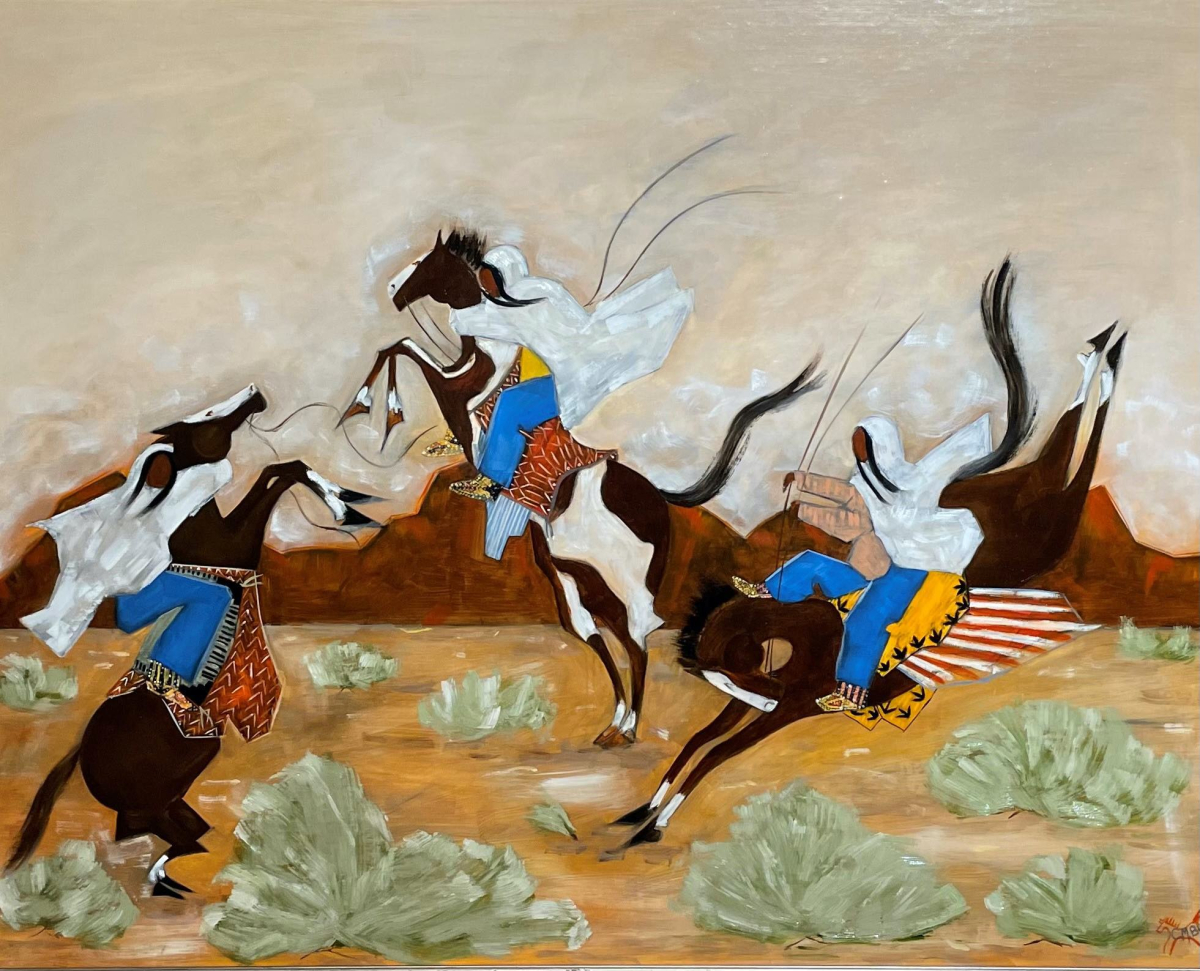
Cold Morning in the High Desert
Chloé Marie Burk
oil on linen board
24 x 30 inches (L x W)
Born in Poitiers, France, Chloé Marie Burk grew up in the French countryside in a family of artists and artisans. While Burk started creating art at a young age and studied fashion in London and Paris, she had “always known” that something was waiting for her in the United States, and she moved to New York City in 2013. Her work, however, is inspired by the simple way of life and country living of her childhood, hard to find in the bustling city, and she quickly moved westward. Currently, Burk lives in Geyser, Montana, and is interested in preserving the Old West in a modern way through her work. Similar to many others in her field, she has studied and recreated artwork by old Western masters such as W. H. Dunton and Frederic Remington to give her own work, which aims to capture the truth and feeling of the Southwest, a classic feel. Until recently, Burk spent half her time in Taos, a town that she finds “perfect.”
parsonsart.com
chloemariegaillard.com
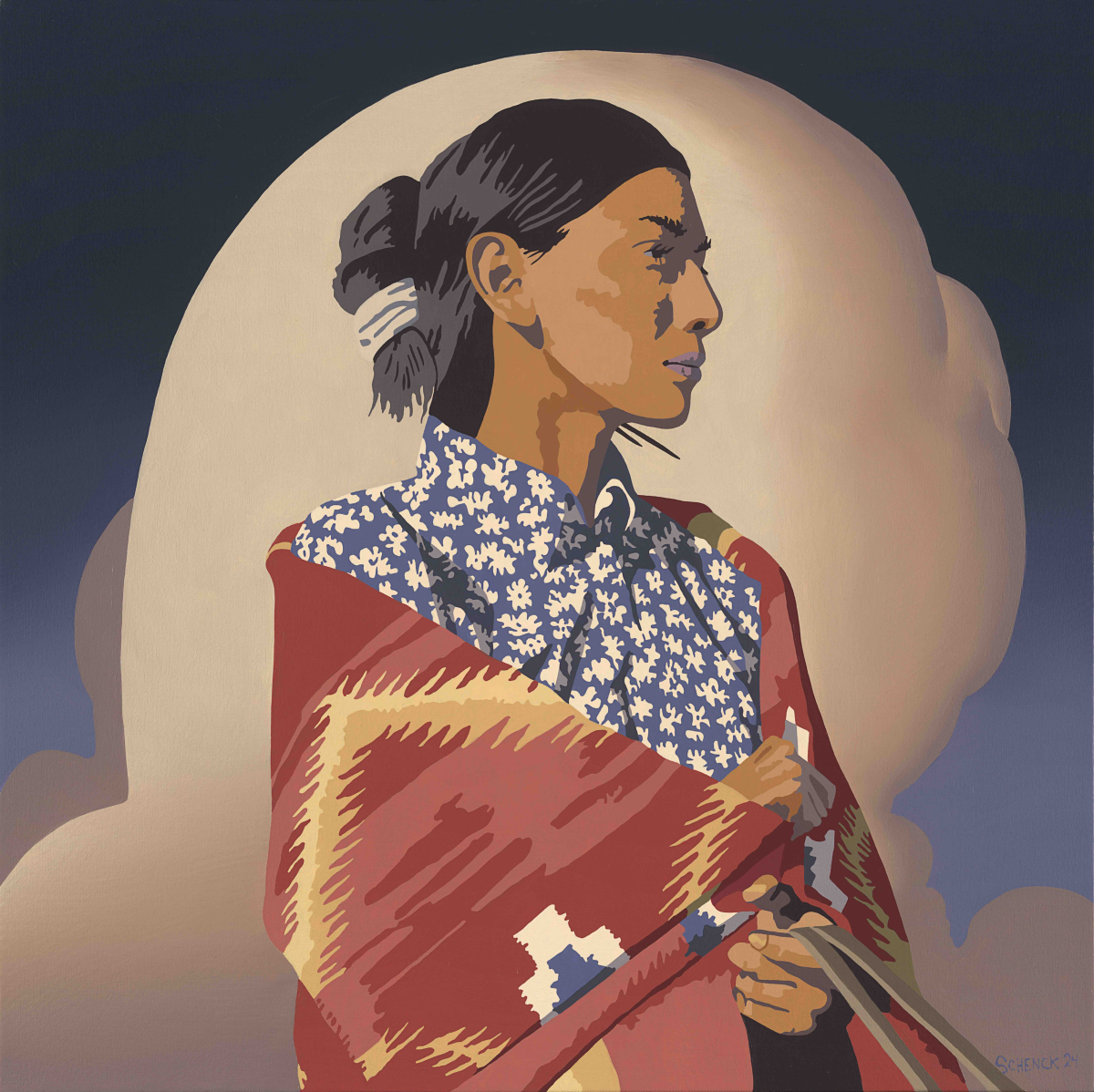
Contemplation
Billy Schenck
oil on canvas
24 x 24 inches (L x W)
Billy Schenck is a contemporary artist with work in more than 40 museum collections and corporate collections that include Sony, IBM, Saatchi and Saatchi, American Airlines, and others. His subject matter spans genres from Western landscape to cowboy pop. He has been exhibited widely in the United States and Europe. He is a World Champion Ranch Sorting winner and the proprietor of the Double Standard Ranch in Santa Fe, his home for the past two decades.
billyschenck.com
$13,000
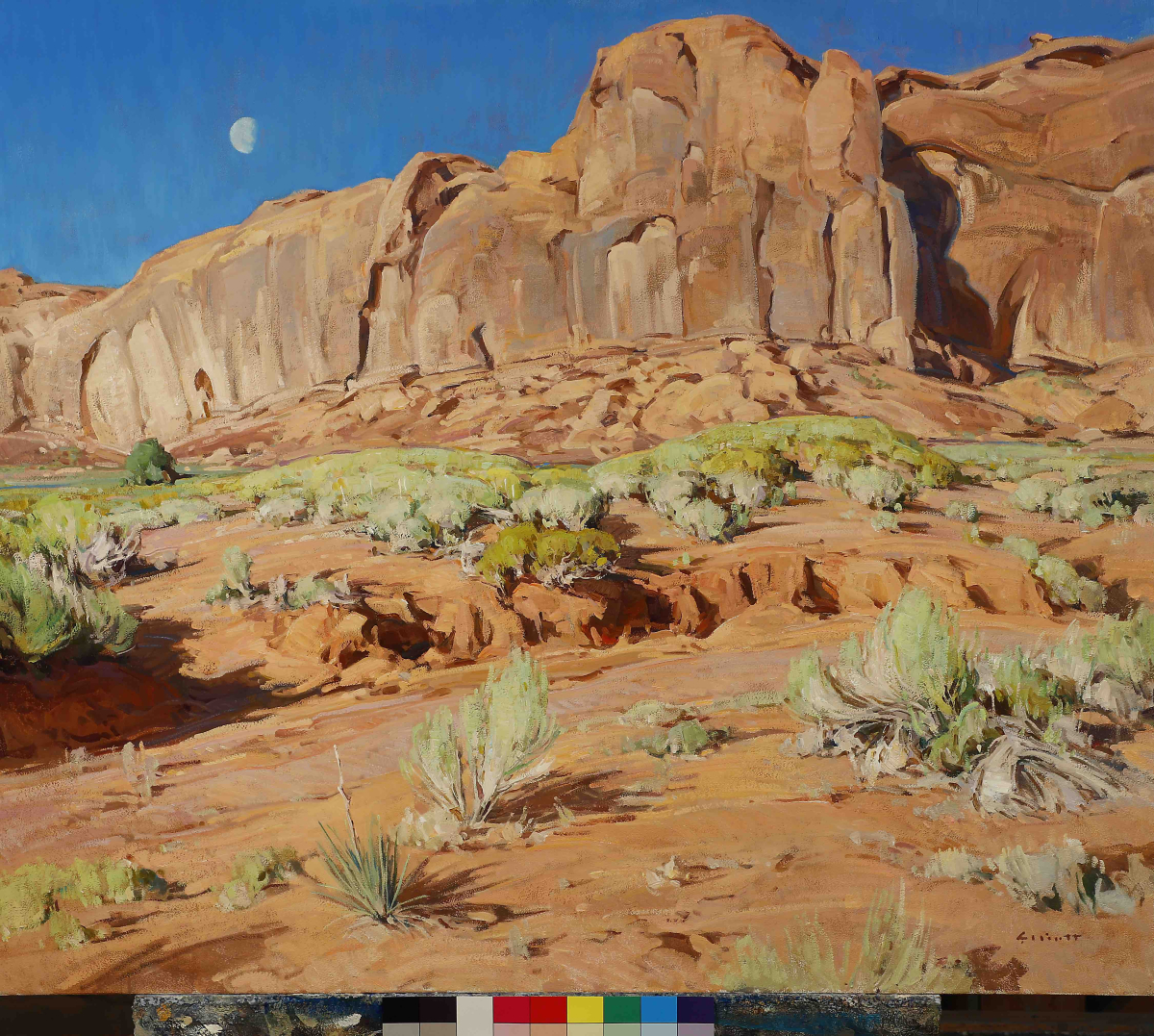
Day Moon, Monument Valley
Josh Elliott
oil
24 x 28 inches (L x W)
As a child, Josh Elliott, who is a third-generation artist, was raised with an appreciation for art. In addition to his grandfather, a classmate of Grant Wood’s, Elliott’s father, Steve, has been the most important influence on his career. Elliott learned about not only value, composition, and color from Steve, a wildlife artist, but also the importance of painting outdoors. With a deep respect and awe for Mother Nature, Elliott views his outdoor paintings as reactions to what is in front of him and attempts to “capture the transient light and the overall beauty of [a] place.” To Elliott, who lives currently in Helena, Montana, the terrain of the Southwest provides an interesting intermingling of ancient and modern subject matter. He says, “You can’t help but feel the sense of time in the desert,” and he enjoys portraying the theme of “man against the elements.” Regardless of location or evidence of man’s interference in nature, Elliott tries to “tell the story of the place” in his work.
joshelliottart.com
$11,200
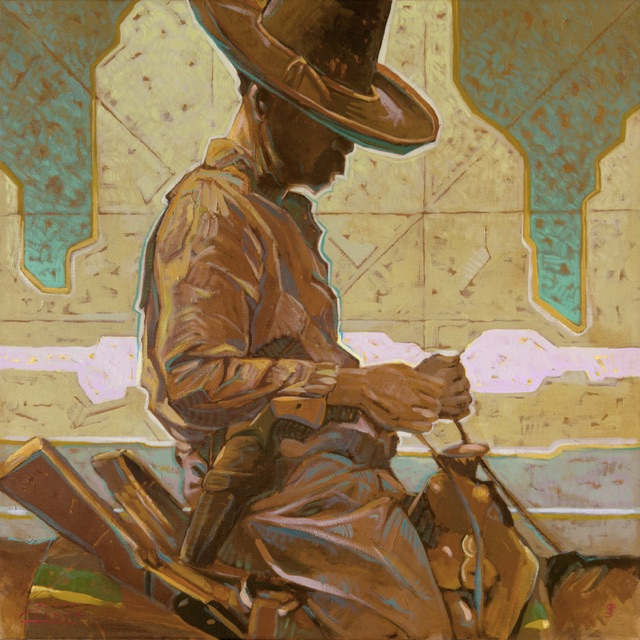
Double Down
S. M. Chavez
oil on canvas
24 x 24 inches (L x W)
Stating that he has “always been artistic,” Sean Michael Chavez has been painting and drawing for as long as he can remember. Rendered in oil paint, Chavez’s compositions present distinctive takes on the land and people of the Southwest through a marriage of old and new. Frequently featuring Native American, cowboy, and Mexican subjects, Chavez’s work reminds viewers of past ways of life and traditions through a decidedly modern style. As Chavez notes, the resulting effect “is my unique vision and experience of being native to the Southwest and more specifically, to the beautiful place known as New Mexico.” Chavez finds a kinship with the land and states that New Mexico “is a place that is part of me more than anything else I can think of. I cannot help but express myself through it. We are one and the same.” Looking forward, Chavez hopes that, one day, his artwork might “inspire the next Dixon, the next Dunton, Couse, or Sharp . . . If that was my role, it would have been well worth living.”
paintingsofthewest.com
$5,500
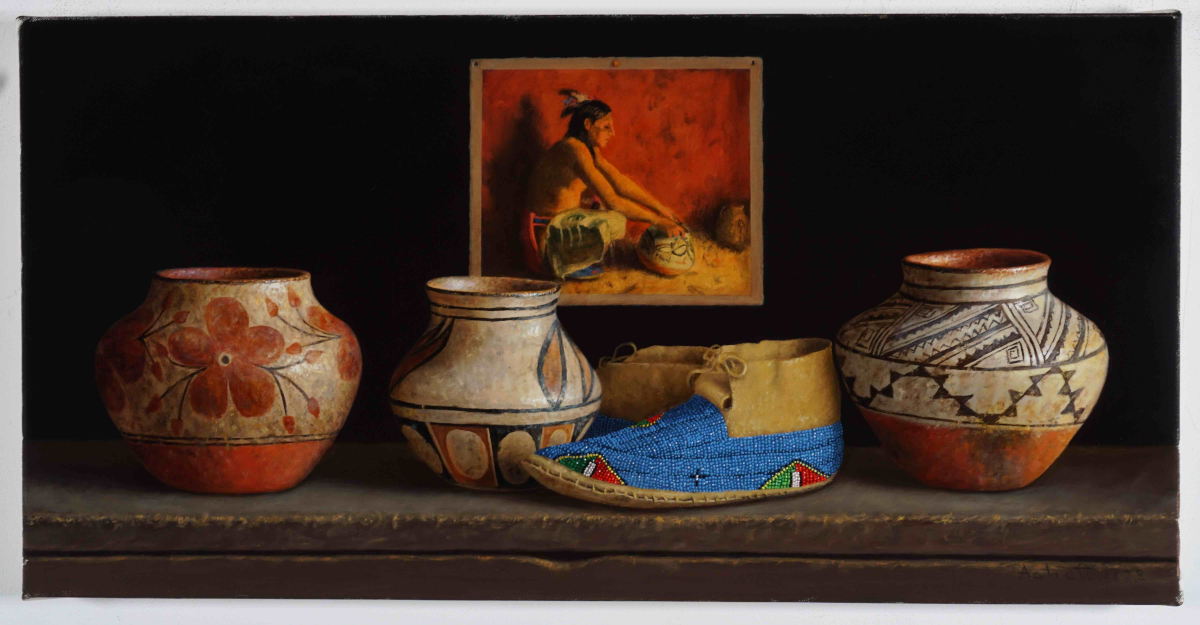
Fancy Potter
Bill Acheff
oil on linen
10 x 20 inches (L x W)
At an early age, Bill Acheff (Alaskan Athabascan heritage) had an intense interest in painting, yet he never dreamed of becoming a professional painter. It took a chance encounter with the Italian artist Roberto Lupetti at a hair salon to reawaken his artistic aspirations. After a European-style apprenticeship with Lupetti, Acheff dedicated himself to painting and honed his trademark trompe l’oeil (“fools the eye”) style of realism. In his compositions, Acheff frequently represents objects and themes indicative of the Southwest. Specifically, his work often contains artifacts from different Native American cultures, for which he has a special affinity. As Acheff explains, “Artifacts and traditions of the past seem to hold more mystical and aesthetic value than those of contemporary times.”
In 1973, Acheff moved to Taos, a major turning point in his career, one which allowed him to find his niche and “develop my own style early on.” When asked about motivators for his practice, Acheff states, “I do it for the pure joy of painting . . . and I hope my paintings bring people inner peace.”
acheffstudio.com
$15,000
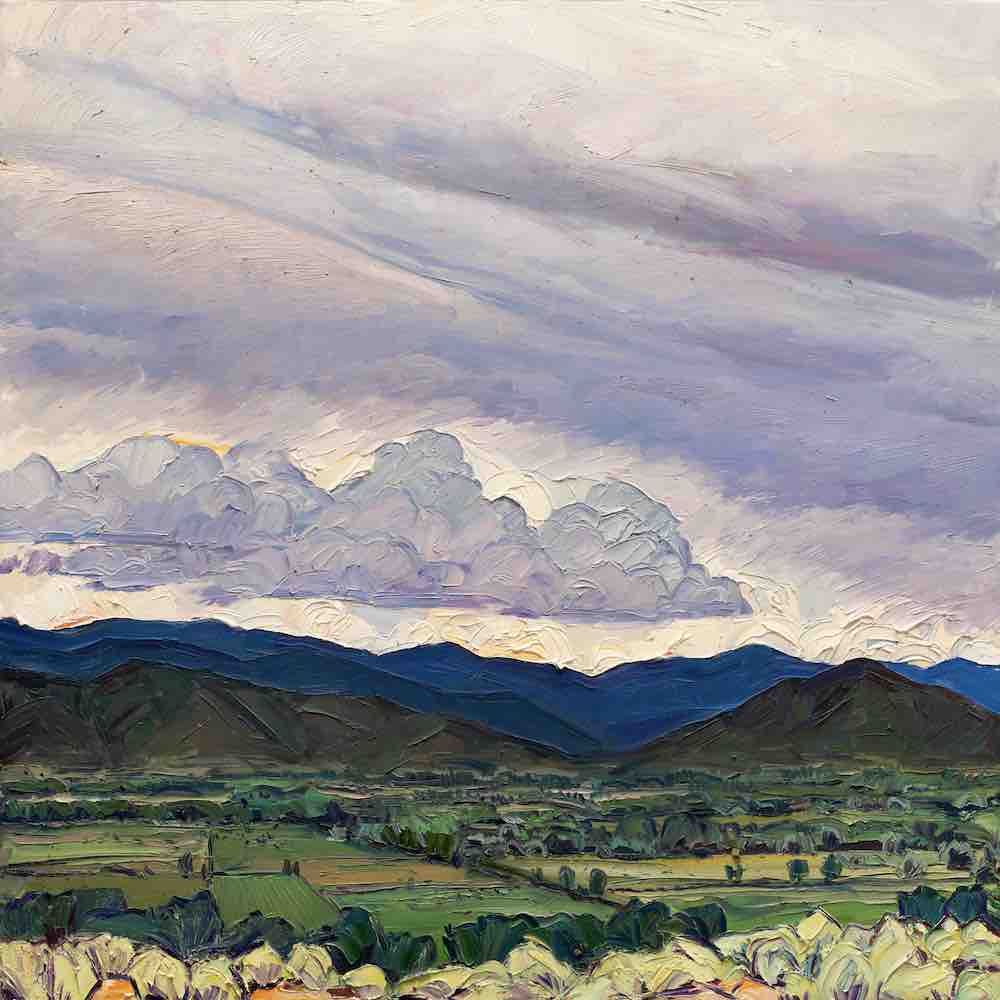
Homeward #12 - Two Flows
Jivan Lee
oil on panel
48 x 48 inches (L x W)
Inspired by the artists and landscapes of the Southwest, Jivan Lee is an oil painter who explores the nature of paint as a raw material and catalyst for emotional response in his work. Now based in Taos, Lee grew up in Woodstock, New York, and studied both environmental policy and painting. As result of his earlier studies, in his artistic practice Lee addresses frequently the complexities of how humans see and shape the environment. Emphasizing the importance of direct observation, Lee creates most of his work outside, on location. Lee is known for the manner in which he puts paint on canvas: he applies thick strokes with silicone spatulas, large brushes, dirt, paper towels, and his bare hands. Up close, the resulting canvases might appear to celebrate “paint for paint’s sake,” though from a distance, the paintings reveal themselves to be studies of landscapes, architecture, light, and figures. When asked about his paint application, Lee notes that, “Paint interests me first on a visceral level . . . it also becomes a remarkable tool for helping us find this world anew . . . for being a vessel for learning and feeling.”
Jivan Lee writes that the painting is “part of my ongoing series from the location [Blueberry Hill in Taos]. This particular day was special because of the two distinct clouds flows; one rising just above the mountains almost like little mounds of popcorn or cotton candy, and the other, larger flow sweeping in from the West.”
jivanlee.com
$16,000
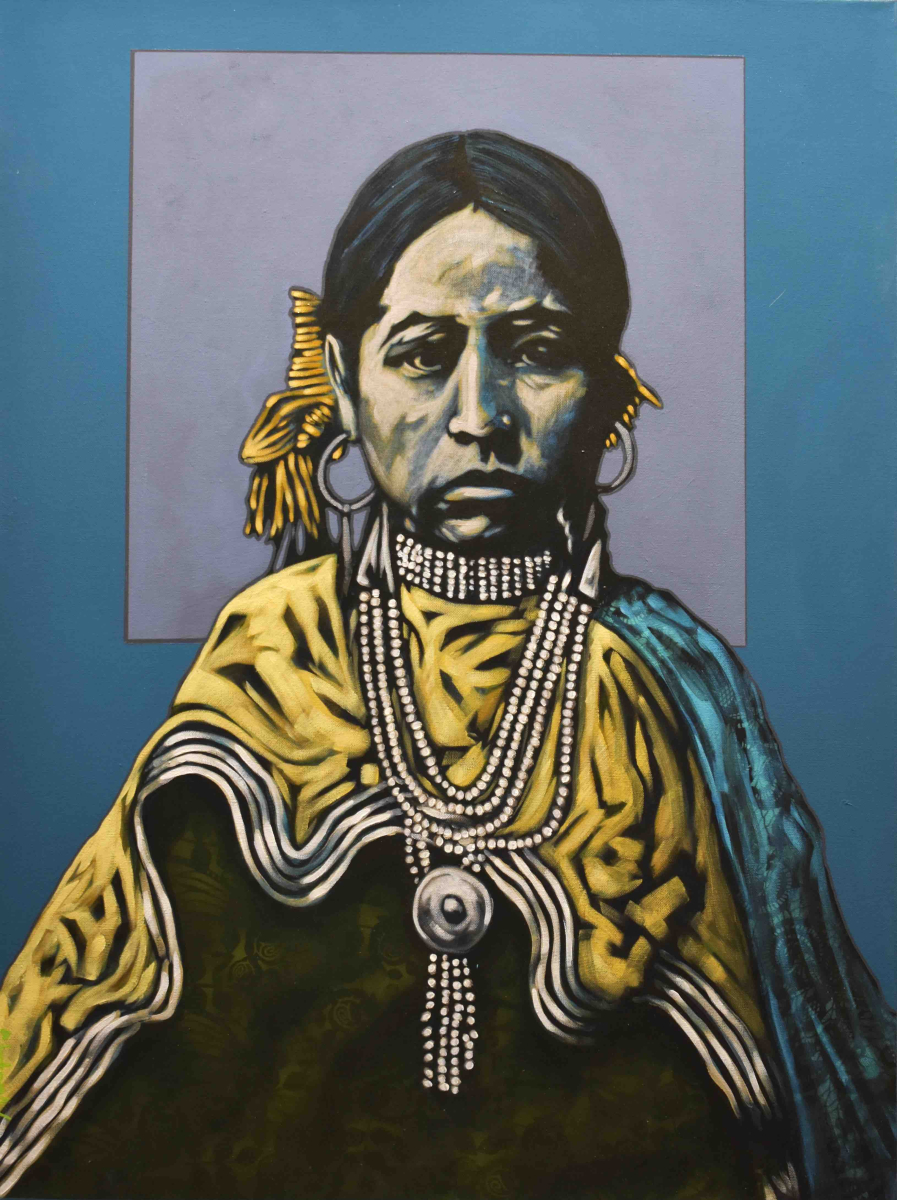
Jicarilla Future
Nocona Burgess
acrylic on canvas
40 x 30 inches (L x W)
Nocona Burgess presents strikingly modern depictions of Indigenous men and women from tribal Nations of North America. Painting with vibrant pigments onto dark backgrounds, Burgess has perfected a method he describes as “painting outward.” This approach produces the richly contrasting colors of his canvases and gives his art a vivid depth. As a member of the Comanche Nation of Oklahoma, the son of a former tribal chief, and the great-great-grandson of one of the most revered Native American leaders, Chief Quanah Parker, Burgess’ paintings mix research, firsthand knowledge, and passion.
Combining brightly colored shapes with crisply outlined facial features and traditional dress, Burgess explores the cultural context, life story, and identity of each sitter. He urges us to update our perceptions of Native people and consider the intriguing and often politicized place of Native American portraiture. Burgess strives for an intimate connection with each subject, eager to know their characters. Through his paintings, he thanks his ancestors for their sacrifices in helping to make Native identity what it is today. Burgess’ paintings inspire and educate through their unusual techniques and positive dialogues between past and present.
noconaburgess.com
$8,000
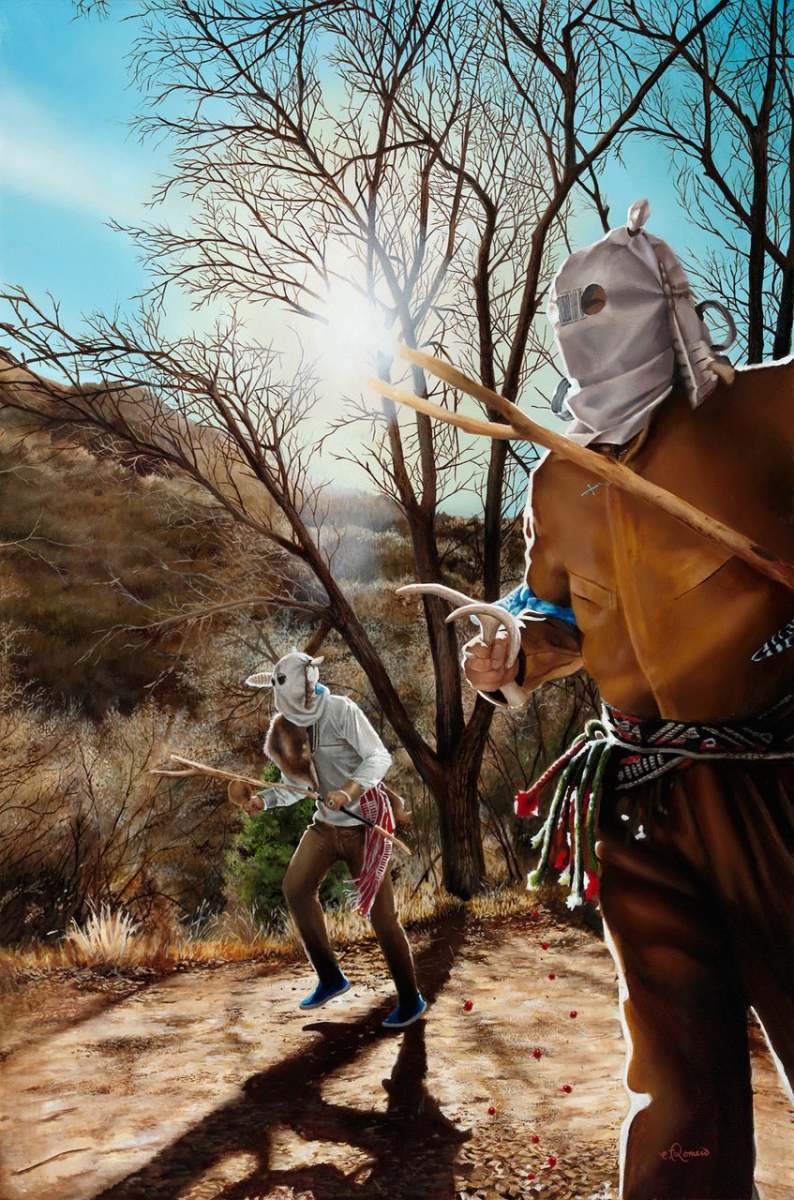
La Luz
Eric Romero
oil on canvas
36 x 24 inches (L x W)
Eric Romero’s art explores the relationship between myth, philosophy, and culture. Born and raised under the New Mexican sun, Romero draws inspiration from the Land of Enchantment. His allegorical figurative paintings echo the Old Masters in technique and methodology. Catholicism, mythology, and the New Mexican social landscape have influenced his oil paintings to tell a rich story of history, culture, and mysticism. Working in the medium of oil, he tirelessly and painstakingly pays close attention to detail within the paintings and often paints hidden symbology within the composition. As a self-taught artist, Romero creates paintings with a feeling of mannerism, combining bold color with metaphorical imagery.
The painting depicts the Dance of the Los Comanchitos in Carnue, New Mexico, a ceremonial dance celebrating the heritage and history of the Genízaro people. Masked dancers adorn themselves with clothing rich in symbolism and deliver blessings as they pay homage to the land, religion and people of New Mexico.
Genízaros were an ethnic assemblage of individuals and communities of Native peoples of mixed origins, mostly Apache, Navajo, Ute, Paiute, Kiowa, Comanche, and Pawnee. Groups with common bonds of language, culture, and family were called naciones (nations), similar to the modern usage of the word “tribe.” Genízaros entered Spanish colonial society in the early eighteenth century as captives taken during frequent skirmishes with the numerous enemy "nations" that surrounded the upper Río Grande region (Brooks 2002). Some Pueblo groups such as the Hopi-Tewa of Abiquiú and others became Genízaro by displacement and relocation (Córdova 1979).
Of this painting, Romero writes:
In the intricate tapestry of history, our journey unfolds—a quest for truth illuminated by La Luz, the radiant mother guiding us through the multifaceted layers of identity, place, and home.
Under the expansive New Mexican sky, diverse origins converge, their stories woven into the interplay of light and shadow. Here, amidst the shifting shadows, our community's resilience and perseverance stand as steadfast beacons, weathering adversity with grace.
The sunlight filters through branches, grounding us in the roots of our heritage—both ancient and new—offering moments of solace and reflection. Amidst the vast desert expanse, we stand as testaments to a shared legacy of cultural resilience, each nuance of identity illuminated by the unyielding light.
Oppressor and oppressed, ancient and modern, whispers through the branches, the enduring spirit of the Genízaro people echoes—a tireless quest for truth, an eternal pursuit of light within the rugged embrace of Nuevo Mexico's landscape.
Yo Soy. Soy de allí, soy de aqui. Soy Genízaro.
ericromeroart.com
$6,000
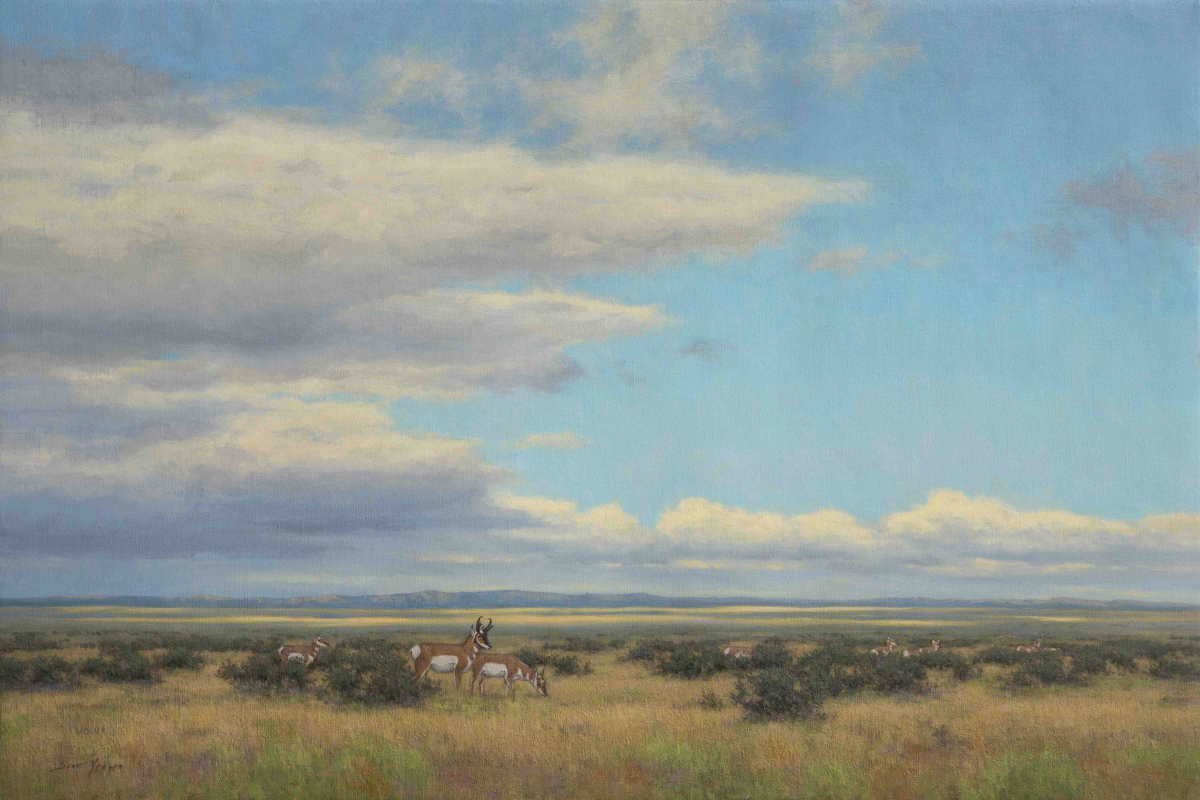
Llano Estacado
Scott Yeager
oil on linen
24 x 36 inches (L x W)
An avid fisherman and all-around outdoorsman, Scott Yeager offers a visual diary of his love for the outdoors through his paintings. In his youth, Scott filled sketchbooks with drawings and paintings of plants, animals, and all things of the natural world that inspire him. He could often be found seated beside a marsh or river with a field scope and a sketchpad, studying the forms and rhythms of waterfowl. In his adulthood, Scott studied at the prestigious Scottsdale Artists School in Arizona and has sought individual study with other artists. Firsthand experience of the subject is at the core of his work, and he creates a constant flow of plein air paintings as a result. Many of these stand on their own as works of art, and many are the springboard for more developed and larger works in the studio. Scott's travels take him from Maine in the East to Alaska in the West. Most of his favorite destinations are in the Rocky Mountains and the Southwest. Scott resides in Woodland Park, Colorado, with his wife, Marie, and their son, Joseph.
scottyeager.net
$9,000
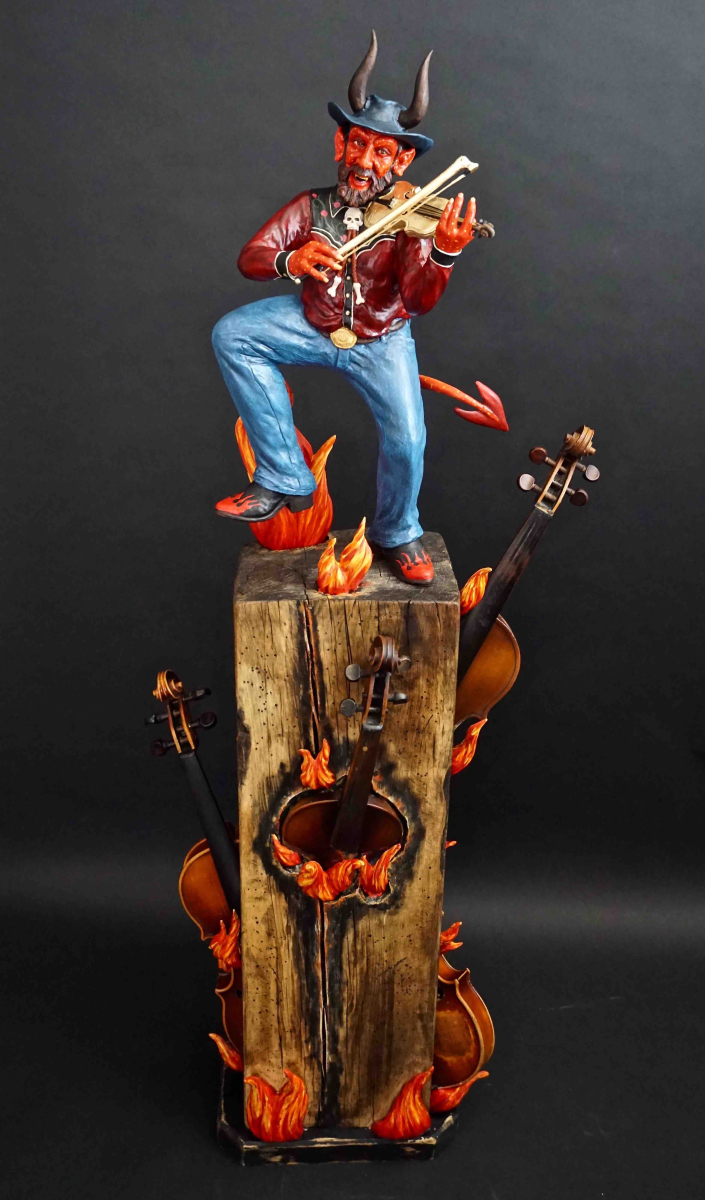
Lookin' for A Soul to Steal
Arthur López
wood, natural and water based pigments, gold leaf, found objects
52 x 22 x 11 inches (L x W x D)
Born and raised in Santa Fe, Arthur López is proud to be working in the long tradition of New Mexico santero artists. His close attention to detail has garnered him many awards, and he is esteemed as one of the state’s most popular santero sculptors in wood. López explains, “My work comes out of my faith. I am a firm believer that you can still use traditional methods to create contemporary work. Though the majority of my work is of Saints, you do not have to be of any particular religion to appreciate them as art." Equally important to López is his need to transcend the bounds of the traditional santero and use his art as a medium for expressing the full range of his culture and the world around him. López notes that this piece was inspired by the 1979 Charlie Daniels song “The Devil Went Down to Georgia.”
“The Couse-Sharp Historic site is one of Taos’s greatest assets. The site has played an important role since its founding in drawing and cultivating artists and creative professionals of all stages and genres, creating a successful creative diverse and multi-cultural arts community,” López says.
artlopezart.com
$12,500
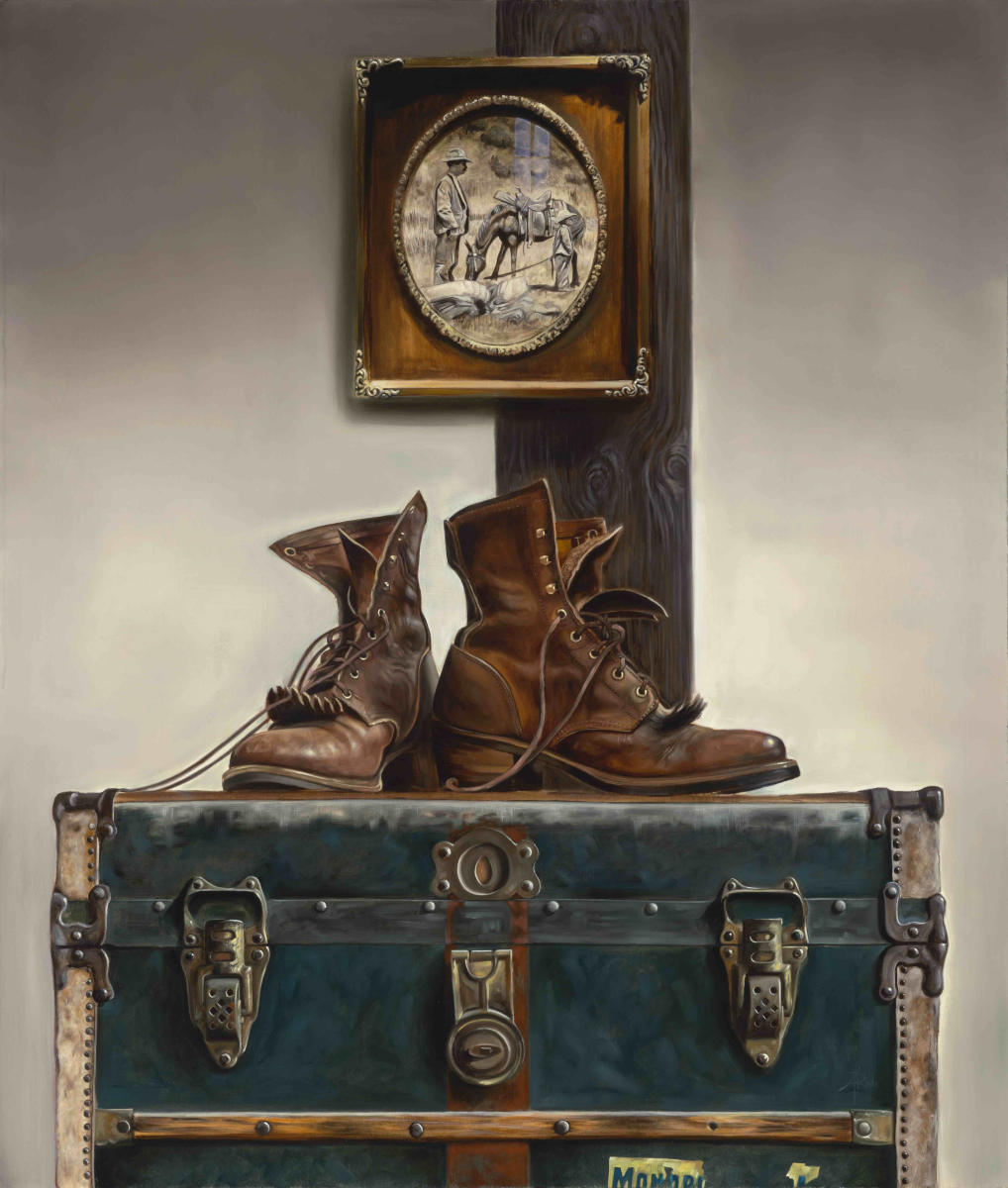
Oh, The Places They'd Go
Andrew Roda
oil on canvas
26 x 22 inches (L x W)
Andrew Roda’s development as a Western realist painter comes through a combination of personal heritage and an appreciation of the objects of classic Americana and their stories. His appreciation for the subject lies in a belief that everyday objects are artwork in and of themselves. From the craftsmanship and skill that went into making an object to the stories they tell through wear and tear, Roda finds value in the details of everyday objects. Through detail, scale of work, and soul, his paintings are his way of capturing the beauty inherent in these objects and imprinting that sense of appreciation on the canvas.
Roda writes of this painting:
The story of this painting shares literal and figurative references to Couse history as well as moments from my own life. The picture in the frame is referenced from a real photograph taken by E. I. Couse of fellow Taos Society of Artists member Bert Geer Phillips during a camping trip in 1910.
I came upon this image while exploring the nitrate negatives archive at The Lunder Research Center in October 2023. I was enamored with the man and boy staring off together into the distance (to me, seemingly looking off into the future of what adventures could lie ahead). The boots and trunk connect this theme of exploration and adventure. Where have these boots traveled? What memories and trinkets lay inside this trunk from a life lived? The boots are an old pair of mine (I colloquially call them my “chimney sweep boots”), but they also pay homage to a favorite childhood poem Ickle Me, Pickle Me, Tickle Me Too from Shel Silverstein’s book Where the Sidewalk Ends. The boots bare resemblance to Shel’s “flying shoe” navigated by the adventurers in the poem.
Aside from its visual appeal, the trunk makes another connection directly to Couse history—it was owned by Kibbey Couse, and sits under a stack of books in his office at the site. I took notice of it several years ago during my first visit. Over the past several months, Marissa Hendriks (Director of The Lunder Research Center) and I explored its details and nuances, attempting to play forensic scientist on its adventures. I was able to surmise that one of the fragmented stickers (which I included in the painting) likely said Monopol Hotel. Two prominent hotels under this name were opened in the early 1900s in Wroclaw and Katowice, Poland. Perhaps Kibbey visited the location during his travels in WWI? We don’t know, but the answer lives somewhere between the facts we know and the mysteries we whimsically fill in, and that’s part of the fun.
Continuing the theme of adventures and literature, the title of this painting is an homage to Dr. Seuss’s Oh, The Places You’ll Go, which encourages children to embrace both the adventures and challenges in life. The message to its readers was that life is full of ups and downs, but it’s important to keep moving forward and never give up on your dreams. With a litany of nuggets personal to both myself and the Couse-Sharp Historic Site, I’m so excited to contribute in celebration of the Site. May it help share the appreciation and reverence I hold for the Site and community that surrounds it, and help inspire new stories on a journey all its own.
rodastudios.com
$5,495
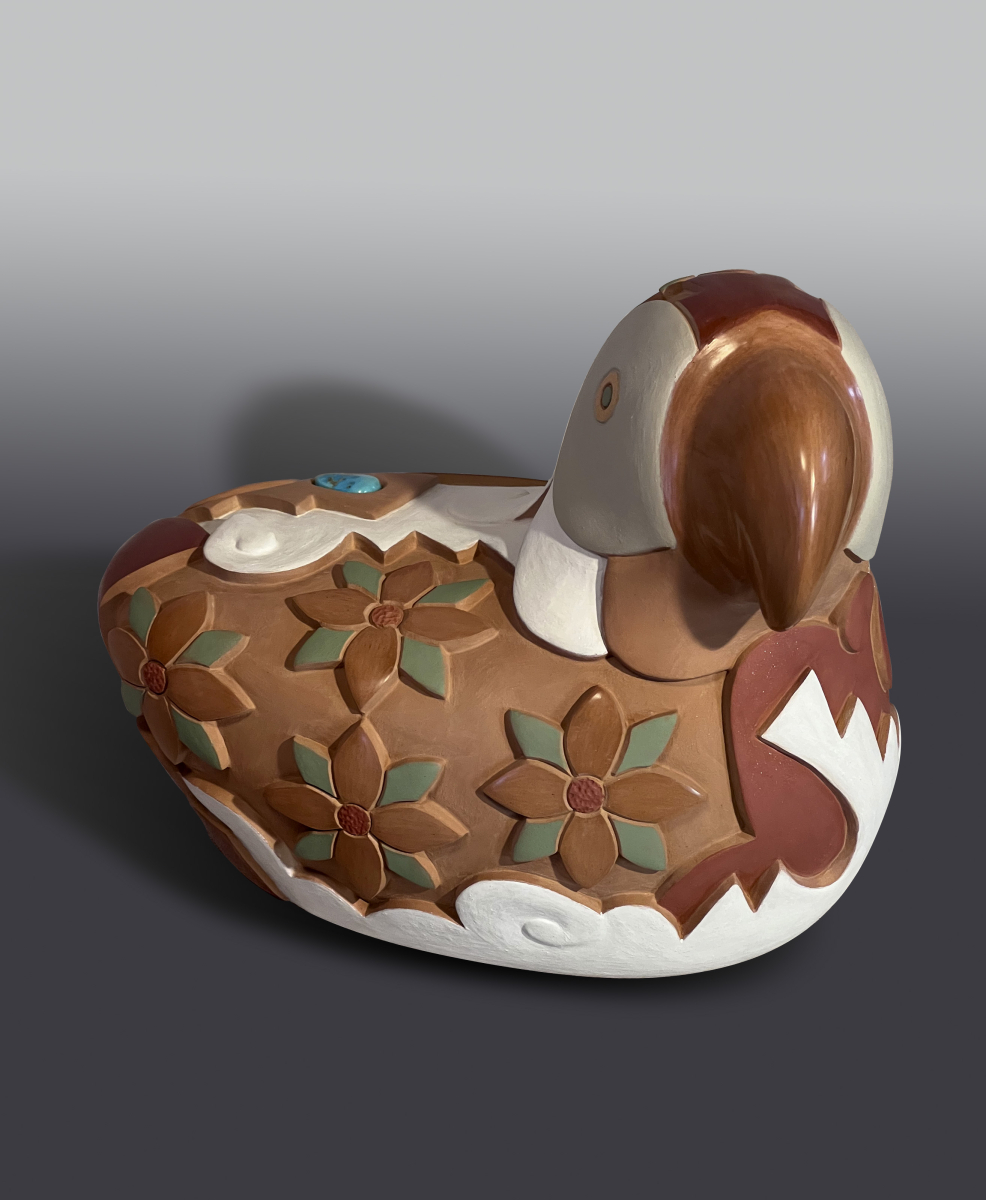
Prosperity Parrot
Autumn Borts-Medlock
hand-coiled clay, burnished and painted slip, turquoise
6.25 x 8 x 7.75 inches (L x W x D)
Growing up in Santa Clara Pueblo, in a family whose connection to clay goes back generations, pottery has always been an important part of Autumn Borts-Medlock’s life. She began working with clay at an early age under the guidance of her mother and grandmother in the ancient Pueblo technique of coil-building. The lessons she learned working alongside them, sculpting clay they gathered and processed themselves and drawing from the spiritual symbolism and nature-oriented aesthetics of Tewa culture, solidified Borts-Medlock’s connection to clay and gave her the skills to move into her own work. Today Borts-Medlock continues the traditions instilled in her by her mother and grandmother and says, “They remain among my strongest influences even now.”
Although she no longer lives in the Pueblo, she says that her connection to the Tewa people and culture is sustained by “the clay itself” and that her work is defined “more by cultural legacy than by place, more by experience than by genealogy. It becomes part of the larger collective memory of heritage.” The artist has won numerous awards at Santa Fe Indian Market, and her work is in the permanent collections of the Denver Art Museum and Heard Museum, among others.
autumnborts-medlock.com
kinggalleries.com
$10,250
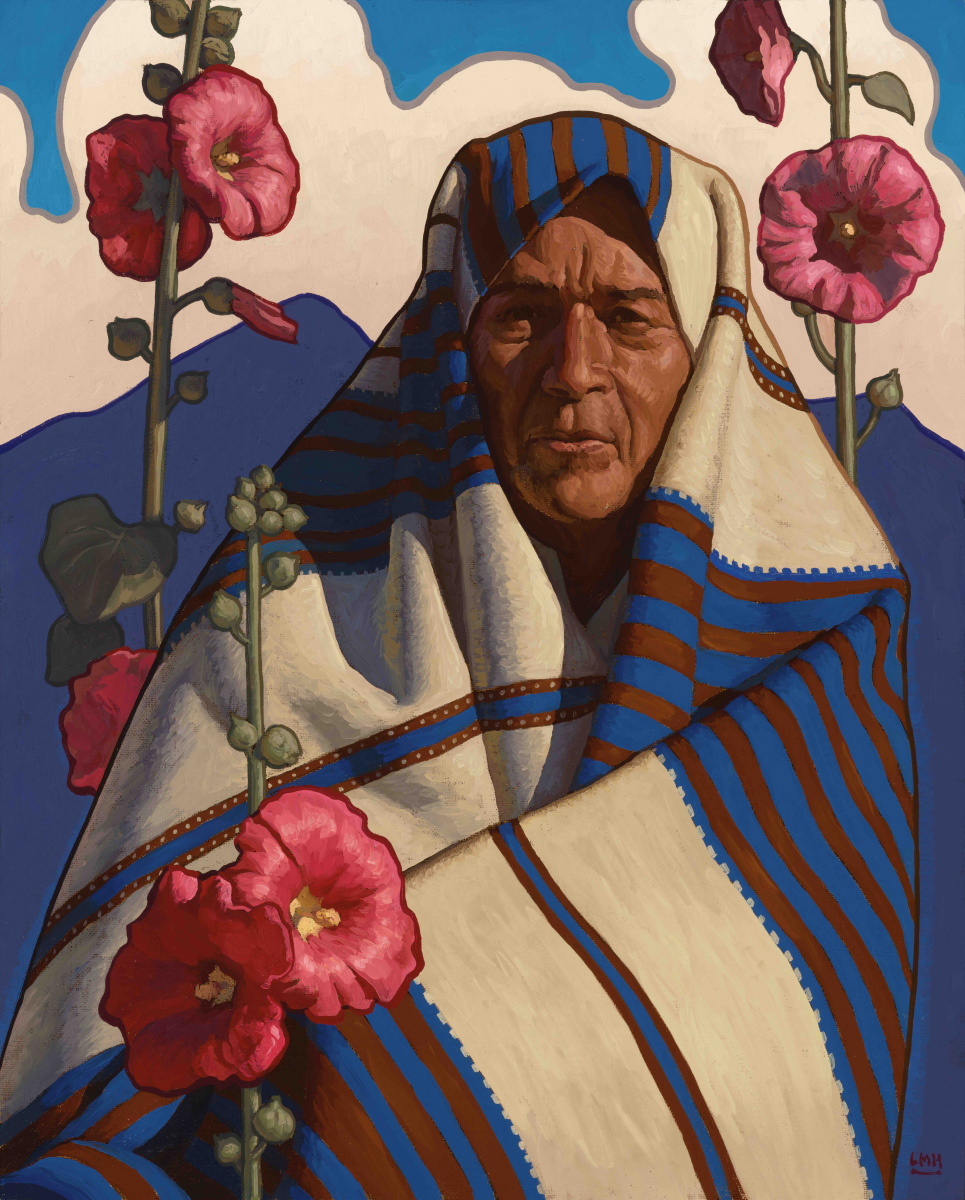
Rio Grande and Hollyhocks
Logan Maxwell Hagege
oil on linen
20 x 16 inches (L x W)
As a young boy, Logan Maxwell Hagege showed significant ability and interest in creating art. Visits with his grandmother who lived in the Californian desert provided inspiration for his early practice. Today, working out of a studio in Ojai, California, Hagege creates modern visions of the American West in a style he has coined “stylized realism.” In his paintings, the sky is prominent, and his signature clouds frequently mimic the forms of the cowboys and Native Americans in the foreground. To gather subject matter and establish deeper relationships with the land and peoples of his paintings, Hagege travels extensively throughout the Southwest and southern California.
In addition to finding inspiration in nature and his subjects, Hagege has been guided by the work of painters such as N. C. Wyeth, Maynard Dixon, and Gustav Klimt. While he might be influenced by a particular location, Hagege notes that the scenes that he creates are solely original: “It’s my vision of the world; that’s where it starts and that’s where it ends.”
loganmaxwellhagege.com
Minimum Starting Bid: $10,000*
*This work will be sold by maximum, secret bid.
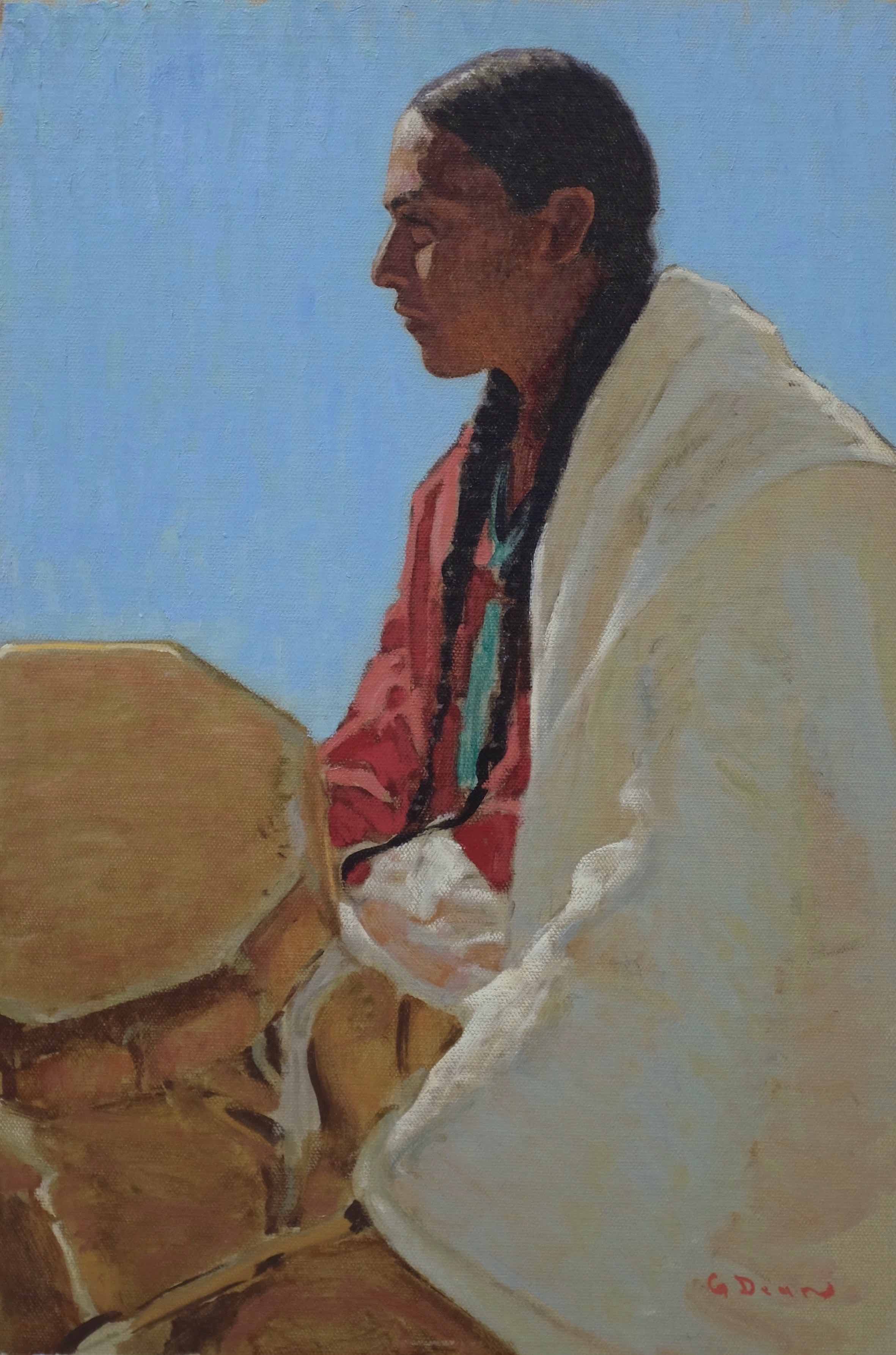
Taos Dreamer
Glenn Dean
oil
18 x 12 inches (L x W)
Largely self-taught, Glenn Dean was aware of his interest in creating art by age 13, but it took several years for him to realize his passion for landscape painting. At the age of 20, Dean completed his first outdoor painting in Arizona, and he has been dedicated to the art form ever since. Early in his career, the work of Western landscape painters of the early 20th century, including Maynard Dixon and Edgar Payne, directed the path of his own practice. From these influential artists, Dean learned to observe carefully “the simple and basic characteristics of a specific location” while recognizing the “importance of seeing the color of light.” Painting on location throughout the Southwest, including four years spent in New Mexico, Dean is intrigued by the relationship between a figure and their surroundings. With a bold, graphic look to his compositions, Dean’s artwork aims to honor “the things in the world that [he] finds to be beautiful.”
landscapesofthewest.com
Minimum Starting Bid: $6,000*
*This work will be sold by maximum, secret bid.
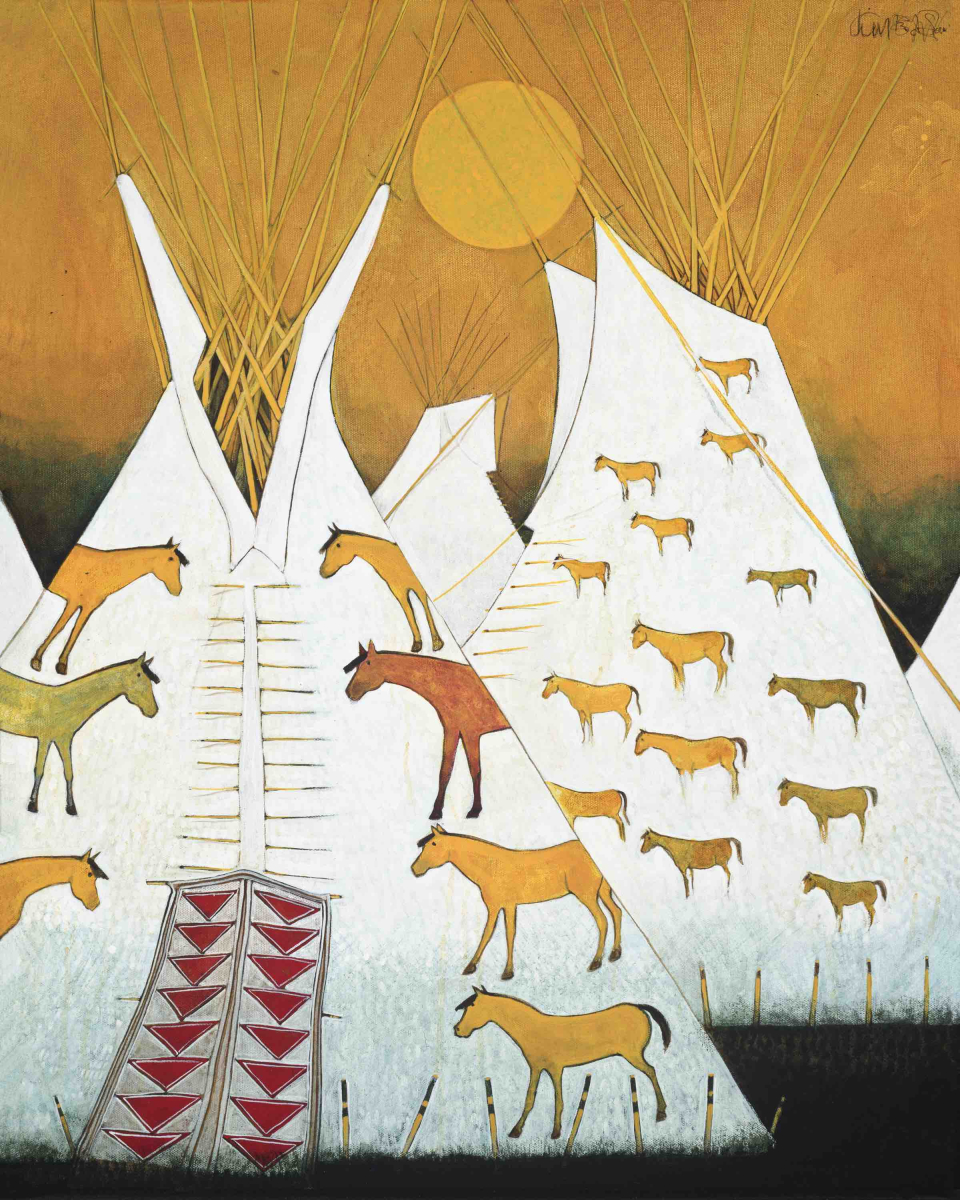
Two Horse Tipis
Kevin Red Star
acrylic on canvas
30 x 24 inches (L x W)
Kevin Red Star’s art is honored throughout Native America for its authenticity. It presents a vision of centuries-old Crow (Apsaalooka) culture through the eyes of a thoroughly contemporary consciousness. In the world of museums and private collections, he is respected for his unique imagery, artistic productivity, and the enduring value of his work. Red Star grew up on the Crow reservation in southern Montana, a member of a highly creative family. He was among the first group of students at the Institute of American Indian Arts in Santa Fe in the late 1960s, when the founders visited Native villages and reservations and recruited the most talented youngsters from each.
He is known for attention to historical detail in his depictions of warriors, ceremonies, costumes, and tipis. Each element, no matter how small, has specific meaning within the context of tradition. Red Star’s deep experience is expressed in color and composition, and his subjects spring vividly to life through masterly style and technique. Red Star continues to evolve and refine his art in his studio near the Crow reservation and the resort town of Red Lodge, Montana. He also spends time in Santa Fe, where his career began.
kevinredstar.com
$16,000
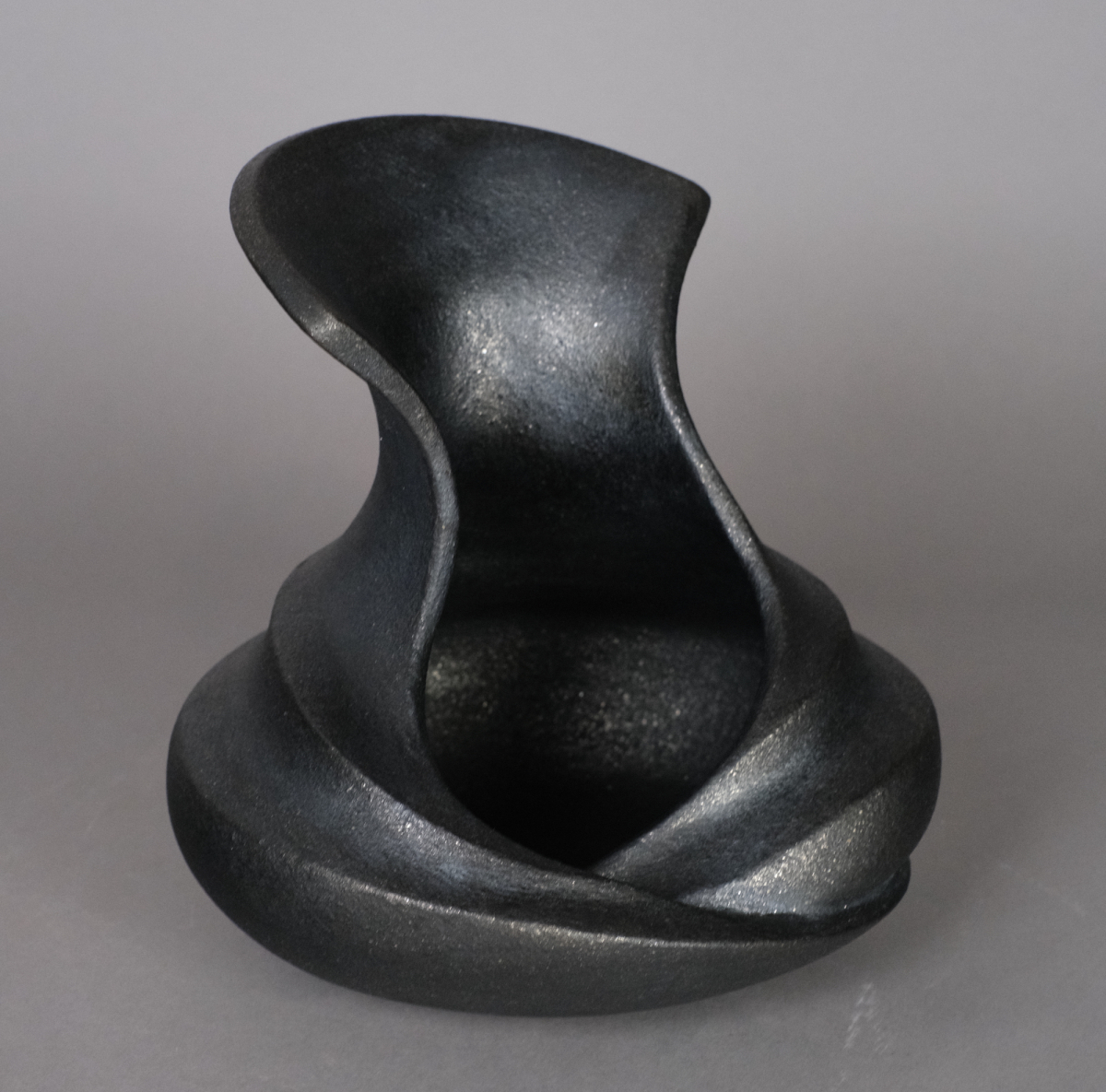
Water and Fire
Yellowbird Samora
micaceous clay, slip and reduction fire
Son of Frank Samora, a well-known model and public figure of Taos, Yellowbird Samora is a potter from Taos Pueblo who works with micaceous clay. Samora first attempted pottery while at a boarding school in Colorado. He had an accident while skiing, which resulted in a broken back. “During the accident I had a vision of myself in a wheelchair with a sketchpad,” he said. As a result of the accident, Samora enrolled in the Institute of American Indian Arts, where he took pottery classes with Preston Duwyenie and Diego Romero. Through these classes, he learned traditional pottery skills and developed his own style. Pottery is a part-time endeavor for Samora because “there are too many things to do in life.”
$4,700
